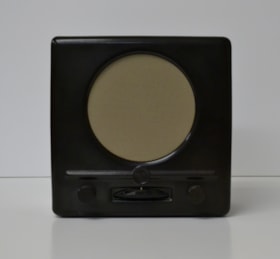Radio
https://www.cjhn.ca/link/cjhn78291
- Collection
- Montreal Holocaust Museum
- Description Level
- Item
- Material Type
- object
- Physical Description
- Radio : black, brown, gray, white ; Ht: 24 cm x W: 24 cm x De: 11,5 cm
- Date
- 1938
- Collection
- Montreal Holocaust Museum
- Description Level
- Item
- Material Type
- object
- Physical Description
- Radio : black, brown, gray, white ; Ht: 24 cm x W: 24 cm x De: 11,5 cm
- Other Title Information
- Sound Communication T&E
- Date
- 1938
- Physical Condition
- Excellent
- Language
- German
- Notes
- Circular speaker opening covered by a greyish fabric. On the b. part are three knobs. Two of them are round. The c. one is a flat wheel marker with numerical scales. Half of the number are white, 1 to 100, and the other half, 1 to 90, are red. Directly above the dial is a Reichsadler in a circle. the back of the radio is a see through metal grid and printed references about the item. One 1.2 cm hole and a 3.4 cm vent are on the b.l. On the b. are four connector holes; E, A1, A2 and A3. Narrative: The German Reiich's ministry of propaganda heavily subsidized the production of inexpensive radios so that Germans could listen to Nazi propaganda and rallies. This model was the simplest radio found in Germany. It was a smaller version of the Volksempfänger (VE 301) – the "People's Radio". The VE 301 was sold for 76 Reichsmark while the DKE 38 was sold for 35 Reichsmarks, the average one week salary. They were nicknamed Goebbels-Schnauze meaning "Goebbels' snout" since his voice was often heard on the radio stations. The VE 301 was introduced in 1933 and the DKE 38 in 1938. By 1938, the number of radios in German household was near 9 million, about half the German homes.
- Accession No.
- 2015.06.01
- Name Access
- Fiset, André
- Places
- Germany, Europe
- Archival / Genealogical
- Archival Descriptions
- Repository
- Montreal Holocaust Museum
Images
{{ server.message }}


